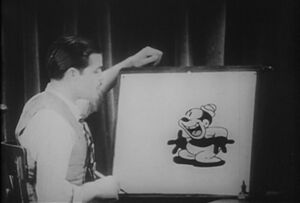Bosko, the Talk-Ink Kid
From Hey Kids Comics
| ||||||||||||||||||
| [Source] | ||||||||||||||||||
| Bosko, the Talk-Ink Kid | |||
|---|---|---|---|
| Looney Tunes series | |||
| |||
| Directed by | Hugh Harman and Rudolf Ising | ||
| Produced by |
Leon Schlesinger Eddie Selzer | ||
| Voices by | Carman Maxwell | ||
| Animation by |
Friz Freleng Rollin Hamilton | ||
| Studio | The Vitaphone Corp. (with Western Electric Apparatus) | ||
| Distributed by | Warner Bros. Pictures, Inc. (as Warner Brothers Production) | ||
| Release date(s) | May 1929 | ||
| Running time | 5 min (1 reel) | ||
| Followed by | Sinkin' in the Bathtub | ||
Bosko, the Talk-Ink Kid is a 1929 live-action/animated short film produced to sell a series of Bosko cartoons. The film was never released to theaters, and therefore not seen by a wide audience until 2000 (71 years later) on Cartoon Network's television special Toonheads: The Lost Cartoons. The film was produced in May 1929 and directed by Hugh Harman and Rudolf Ising.
Plot[edit | edit source]
Rudolf Ising is thinking of ideas for a new character, until he draws a blackfaced person with an ink pen, who comes to life. Ising then talks to the character, and then ask his name. The new character introduces himself as Bosko. Ising tells Bosko to show what he can do. Bosko starts to tap dance, whistle, and sing. After dancing, Bosko looks directly to the screen. Bosko asks who are they. Ising tells Bosko that they are the audience. Ising asks Bosko if he can make them laugh; Bosko agrees to try. Bosko asks Ising if he can draw a piano; Ising does so. Bosko starts to press some piano keys. When one of the keys near the upper end of the keyboard produces a low note, Bosko removes the key and puts in its proper place near the left end of the keyboard. Bosko hits more random notes, then plays a glissando. Bosko laughs, and then sings, "When a day has a great sky", accidentally sliding his tongue out. Bosko opens his hat, pull his hair, letting his tongue to go inside his mouth again. He plays another song, singing, which causes his head to pop out like a slinky. After that, Bosko sings again. Ising said it was enough. He sucks Bosko, who also pulls the piano, back into his fountain pen, and then pours him back to the ink bottle. Bosko then pops out of the ink bottle and promises to return.
Production[edit | edit source]
In 1929, when Walt Disney lost control of his Oswald The Lucky Rabbit cartoon series, producer George Winkler hired away several of Disney's animators to continue producing the Oswald cartoons for Universal Studios. These animators included Hugh Harman, Rudolf Ising, Isadore "Friz" Freleng, Carman "Max" Maxwell, Norm Blackburn, Paul Smith, and Rollin "Ham" Hamilton. Universal later chose to produce the Oswald series using its own in-house animators headed by Walter Lantz, which left Winkler's animators out of work. The unemployed animators decided to produce their own cartoons and made Bosko, The Talk-Ink Kid as a demonstration to show to distributors. Rudolf Ising appeared on-screen as himself in the short and Carry Maxwell performed the voice of Bosko. Harman and Ising shopped for a distributor, but were turned down by both Paramount Pictures and Universal. Leon Schlesinger, head of Pacific Title & Art Studio took an interest in Bosko and used his connections with Warner Bros. to get a distribution deal for a cartoon series that Harman and Ising later named Looney Tunes, a play on the name of Walt Disney's Silly Symphony series.[1]
Home video[edit | edit source]
Bosko, the Talk-Ink Kid is available on disc 4 of the DVD set Looney Tunes Golden Collection: Volume 1 and disc 3 of the Blu-ray set Looney Tunes Platinum Collection: Volume 2.
Preservation[edit | edit source]
The short was considered lost for many decades, with only the film's Vitaphone soundtrack still in existence. By the late 1950s, when the film was being sold in a package on television, it was transferred into 16mm film by Associated Artists Productions in 1956 and was shown on television.[2] Turner Entertainment Co. had a 35mm copy, but did not acknowledge its existence until 1999. The short was later released on DVD.
References[edit | edit source]
- ↑ Maltin, Leonard. Of Mice And Magic: A History Of American Animated Cartoons (Revised ed.). New York, NY: Plume. pp. 223–224. ISBN 0-452-25993-2.
- ↑ 1957 MOVIES FROM AAP Warner Bros Features & Cartoons SALES BOOK DIRECTED AT TV
External links[edit | edit source]
- Template:Bcdb title
- Bosko, the Talk-Ink Kid at Internet Movie Database
- Template:Internet Archive film
- Bosko the Talk Ink Kid on YouTube
- Articles which use infobox templates with no data rows
- 1929 films
- 1929 animated films
- 1920s American animated films
- 1920s animated short films
- 1920s comedy films
- American short films
- American black-and-white films
- American animated short films
- Films directed by Hugh Harman
- Films directed by Rudolf Ising
- Looney Tunes shorts
- Films featuring Bosko
- Films with live action and animation
- African-American films
- African-American animated films
- 1929, May
- 1929
- 1930 Animated Shorts
- Shorts
- Bosko Cartoons
- Black-and-white cartoons
- Looney Tunes Shorts
- Public domain films
- Cartoons directed by Hugh Harman
- Cartoons directed by Rudolf Ising
- Hugh Harman/Director
- Rudolf Ising/Director


